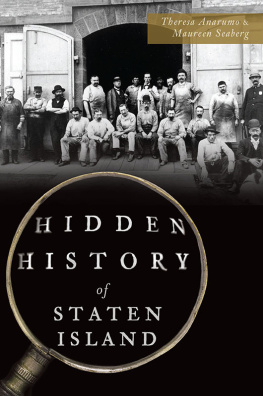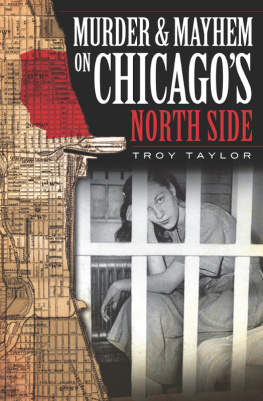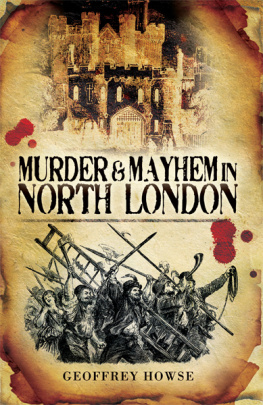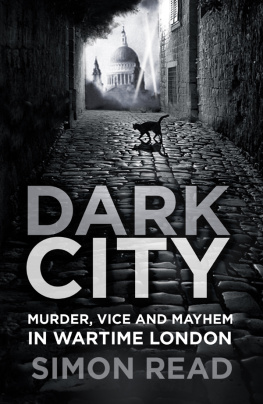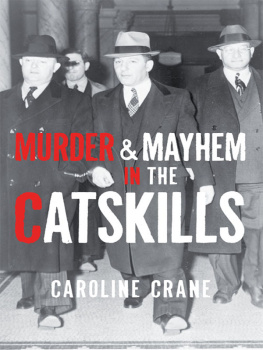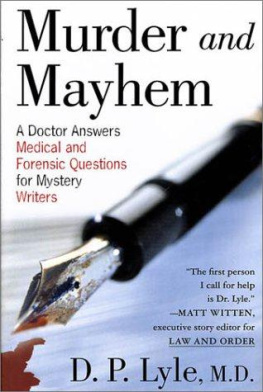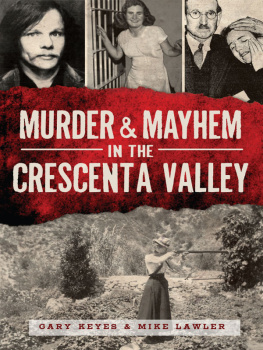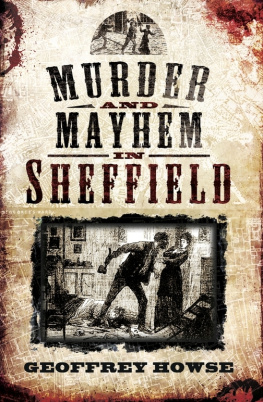
Published by The History Press
Charleston, SC 29403
www.historypress.net
Copyright 2013 by Patricia M. Salmon
All rights reserved
Cover images courtesy of the Library of Congress.
First published 2013
e-book edition 2013
ISBN 978.1.62584.768.3
Library of Congress Cataloging-in-Publication Data
Salmon, Patricia M.
Murder and mayhem on Staten Island / Patricia M. Salmon.
pages cm
print edition ISBN 978-1-62619-283-6 (pbk.)
1. Murder--New York (State)--New York--History. 2. Murderers--New York (State)--New York--History. 3. Crime--New York (State)--New York--History. 4. Staten Island (New York, N.Y.)--History. I. Title.
HV6534.N5S253 2013
364.15230974726--dc23
2013037060
Notice: The information in this book is true and complete to the best of our knowledge. It is offered without guarantee on the part of the author or The History Press. The author and The History Press disclaim all liability in connection with the use of this book.
All rights reserved. No part of this book may be reproduced or transmitted in any form whatsoever without prior written permission from the publisher except in the case of brief quotations embodied in critical articles and reviews.
For Barb, with Barb
CONTENTS
ACKNOWLEDGEMENTS
Sincere thanks are extended to Barbara Hemedinger, Cheryl Criaris-Bontales, Guy Cheli, Tina Kaasmann-Dunn, Beth Gorr, Linda Cutler Hauck, Thomas McCarthy, The Saratogian, Dr. Shari Schindel, sioutloud, Jan Somma and the Tottenville Historical Society.
INTRODUCTION
Murders and murderers fascinate and delight us. We are drawn to the grisly details, and we follow their investigations with keen eyes and avid interest. Think of the O.J. Simpson trial. The public was never so drawn to a court case involving murder as they were drawn to that spectacle.
Some murders are neatly solved. The murdered are discovered. The murderer confesses. The murderer pleads guilty. The murderer goes to prison. Most cases are not that simple. Of course, many are never unraveled. This book presents murders that range from the clearly obvious to the completely complex. Several remain unsolved, but that might change since they are being brought to the publics attention once again.
Staten Island was originally inhabited by the Lenape, a branch of the Algonquin nation. No doubt the first murders took place on the island during the isolated years of Native American inhabitation. We have no record of their occurrences now, but we do know the arrival of white men brought Staten Islands first documented murder. It took place when Captain Henry Hudson and crew sailed into what would become the New York Harbor during September 1609. Their first meeting was positive, with green tobacco, knives and beads exchanged. Relations soured when John Colman and four crewmen left the Half Moon to take water depths. For an unknown reason, the party was attacked, and Colman was killed by an arrow through the throat.
After permanent settlement, various killings and murders took place on Staten Island. One early episode occurred on October 27, 1815. Bornt Lake was walking in front of his Amboy Road property in New Dorp when he was shot dead. It was no mystery who killed him, since Christian Smith ran to a neighbor pleading for advice on whether he should admit guilt or flee. The neighbors response is unknown, but Smith was found wandering aimlessly in a local woodland that same day. Arrested, he begged for forgiveness, stating that he was justified in the act, as he had repeatedly told Lake not to trespass on his land. It seems the two had been bandying back and forth about this issue for quite some time and had made a habit of aggravating and annoying each other on every possible occasion. Neither of the two was sensible enough to stay off the others property, so the matter escalated, ending with grievous results.
The case went before Judge Spencer, who advised the jury that Smith had no reason to kill Lake for trespassing. Smith should simply have reported the trespasser to authorities and used the law to settle the matter. But the jury disagreed, and it set Christian Smith free. The judge was astonished and told Smith, You have another tribunal before which you must appear hereafter to answer for your crime, and where you will not have the benefit of a Staten Island jury. The jury stated that its decision was based on economics. With the astronomical cost of housing, feeding and clothing a prisoner and then building a gallows for hanging, well, it was much more cost-effective to simply free the killer.
Chapter 1
THE BODY IN THE BARREL
Gentlemen of the jury, we design to show to this Court and to yourselves that that man, Edward Reinhardt, who sits before you is a bigamist with a pure girl and the murderer of the one to whom he was lawfully married and whose body we will show was the one buried in such a horrible manner by the lonely lake up on the hills of this island.
Prosecution statement at the murder trial of Edward Reinhardt, May 1879
There was no doubt that Edward Reinhardt had cruelly buried his wife, Annie, in a barrel at Silver Lake. She might even have been alive at the time. He admitted burying her, but ambiguity had swirled around the case ever since the body was discovered by three boys tending cattle on Sunday, September 15, 1878. The road to convicting Edward Reinhardt would be winding at best and mysterious at most.
When the body was found, Louis Reige immediately assumed it was Ellen Murphy, a woman he was unlawfully intimate with and who had gone missing. Reige headed right to the authorities with this information and was at once brought to the Richmond County Poor House at Sea View to identify the decomposing remains. As he viewed the pitiful body on the grass of the Potters Field Cemetery, Reige burst into tears, threw himself beside it and wept convulsively. The woman was so decomposed that only her teeth and hair were recognizable. Physicians believed malpractice (abortion) had been committed, which at this time was unmentionable in polite discussion. As a result, the woman was thought to have died from internal hemorrhaging. Reige insisted that he loved Ellen Murphy and had promised marriage once he found suitable employment. He firmly believed she was the deceased woman. The teeth matched. All who knew Ellen were aware that she did not have an unsound tooth in her headjust like the corpse on view. There was one problem though: the hair color did not correspond. Ellens was light brown, while the deceased had dark brown hair. This mattered little at the time since Dr. William Walser stated that clothes found around the body were saturated with chloride of lime, also known as chloroform. Its presence would turn hair darker. Horrifically, the chemical-laden cloth was believed to have been placed with the body to keep the victim unconscious in case she was not dead and woke up inside the barrel. Another mixture, quick lime, had been lathered on the face to burn away the victims features and render her unrecognizable. Not only was there an adult female body in the barrel, but there was also a self-aborted fetus. Walser acknowledged that the deceased might have died in childbirth.
Those who knew Ellen Murphy were divided. Some thought she was at a local hospital or that she had perhaps returned to Ireland in order to hide until she gave birth. Others claimed that the last time they saw Ellen, she was making her way to Manhattan for an abortion. According to Reige, she had discussed this alternative one month after discovering her pregnancy, but a doctor informed her that she needed to be four or five months along before the procedure could be performed. Rumor had it that a female abortionist, living not three hundred yards from the site where the body was recovered, was involved. Thus, she became an immediate suspect. But the case took a different turn when Gustave Keymer, rumored to be a very eccentric elderly man, came forward. While gathering watercress at Silver Lake about six weeks prior to the bodys discovery, Keymer encountered a man digging a hole at the lake. When asked why he was digging, the man replied that he was burying a New Foundland dog owned by the Cisco family. It was in the barrel on the wheelbarrow he had brought with him. Keymer informed the man that if he buried the dog there, the stench would be a nuisance. As such, the man moved farther down into the ravine and recommenced his labor. This was the exact location where the body was found.



